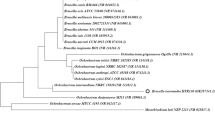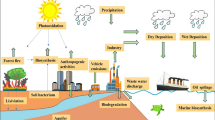Abstract
An investigation was carried out to compare the ability of two bacteria Pseudomonas aeruginosa PSA5 and Rhodococcus sp. NJ2 isolated from petroleum sludge for degradation of benzo(a)pyrene [B(a)P], a HMW PAH compound in MSM. During 25 days of incubation, 50 ppm B(a)P was degraded by 88 and 47 % by P. aeruginosa PSA5 and Rhodococcus sp. NJ2, respectively. Besides, involvement of different catabolic enzymes, that is, salicylate hydroxylase, 2-carboxybenzaldehyde dehydrogenase, catechol 1,2-dioxygenase and catechol 2,3-dioxygenase, was also examined to identify their differential role in B(a)P degradation. Among these enzymes, the highest induction of 2-carboxybenzaldehyde dehydrogenase (773.5 nmol mg−1 protein) was recorded in P. aeruginosa PSA5, while salicylate hydroxylase was highly expressed (839.6 nmol mg−1 protein) in Rhodococcus sp. NJ2. Both the bacteria were found biosurfactant (glycolipid) producing, and role of biosurfactant in PAH degradation was also ascertained by reduced surface tension, higher emulsification index and increased cell surface hydrophobicity.



Similar content being viewed by others
References
Allen CCR, Boyd DR, Larkin MJ, Reid KA, Sharma ND, Wilson K (1997) Metabolism of naphthalene, 1-naphthol, indene, and indole by Rhodococcus sp. strain NCIMB 12038. Appl Environ Microbiol 63:151–155
Anyanwu, Chukwudi U (2010) Surface activity of extracellular products of a Pseudomonas aeruginosa isolated from petroleum contaminated soil. Int J Environ Sci 1(2):225–235
Bouchez M, Blanchet D, Vandecasteele JP (1995) Degradation of polycyclic aromatic hydrocarbons by pure strains and by defined strain associations: inhibition phenomena and cometabolism. Appl Microbiol Biotechnol 43:156–164
Cerniglia CE (1992) Biodegradation of polycyclic aromatic hydrocarbons. Biodegradation 3:351–368
Chang WN, Liu CW, Liu HS (2009) Hydrophobic cell surface and bioflocculation behavior of Rhodococcus erythropolis. Process Biochem 44:955–962
Cooper DG, Goldenberg BG (1987) Surface-active agents from two Bacillus species. Appl Environ Microbiol 53(2):224–229
Desai JD, Banat IM (1997) Microbial production of surfactants and their commercial potential. Microbiol Mol Revol 61:47–64
Franzetti A, Tamburini E, Banat IM (2010) Application of biological surface active compounds in remediation technologies. In: Sen R (ed) Biosurfactants. Advances in experimental medicine and biology. Springer, Berlin, pp 121–134
Goyal AK, Zylstra GJ (1996) Molecular cloning of novel genes for polycyclic aromatic hydrocarbon degradation from Comamonas testosteroni GZ39. Appl Environ Microbiol 62:230–236
Hadibarata T, Kristani RA (2012) Fate and cometabolic degradation of benzo(a)pyrene by white rot fungus Armillaria sp. F022. Bioresour Technol 107:314–318
Heitkamp MA, Cerniglia CE (1988) Mineralization of polycyclic aromatic hydrocarbons by a bacterium isolated from sediment below an oil field. Appl Environ Microbiol 54:1612–1614
Hsu GW, Huang X, Luneva NP, Geacintov NE, Beese LS (2005) Structure of a high fidelity DNA polymerase bound to benzo(a)pyrene adducts that blocks replication. J Biol Chem 280(50):3764–3770
Johnsen AR, Karlson U (2007) Diffuse PAH contamination of surface soils: environmental occurrence, bioavailability and microbial degradation. Appl Microbiol Biotechnol 76:533–543
Juhasz AL, Naidu R (2000) Bioremediation of high molecular weight polycyclic aromatic hydrocarbons: a review of the microbial degradation of benzo[a] pyrene. Int Biodeterior Biodegradation 45:57–88
Kim E, Zylstra GJ (1995) Molecular and biochemical characterization of two meta-cleavage dioxygenases involved in biphenyl and m-xylene degradation by Beijerinckia sp. strain B1. J Bacteriol 177:3095–3103
Kim SJ, Kweon O, Freeman JP, Jones RC, Adjei MD, Jhoo JW, Edmondson RD, Cerniglia CE (2006) Molecular cloning and expression of genes encoding a novel dioxygenase involved in low- and high-molecular-weight polycyclic aromatic hydrocarbon degradation in Mycobacterium vanbaalenii PYR-1. Appl Environ Microbiol 72:1045–1054
Kim SJ, Kweon O, Jones RC, Freeman JP, Edmondson RD, Cerniglia CE (2007) Complete and integrated pyrene degradation pathway in Mycobacterium vanbaalenii PYR-1 based on systems biology. J Bacteriol 189:464–472
Kiyohara H, Nagao K (1978) The catabolism of phenanthrene and naphthalene by bacteria. J Gen Microbiol 105:69–75
Kojima Y, Itada N, Hayaisbi O (1961) Metapyrocatechase: a new catechol-cleaving enzyme. J Biol Chem 236:2223–2228
Krishnan S, Prabhu Y, Phale PS (2004) O-phthalic acid, a dead-end product in one of the two pathways of phenanthrene degradation in Pseudomonas sp. strain PP2. Ind J Biochem Biophys 41(5):227–232
Lily MK, Bahuguna A, Dangwal K, Garg V (2010) Optimization of an inducible, chromosomally encoded benzo [a] pyrene (BaP) degradation pathway in Bacillus subtilis BMT4i (MTCC 9447). Ann Microbiol 60:51–58
Long C, Lu JD, Li A, Hu D, Liu FQ, Zhang QX (2008) Adsorption of naphthalene onto the carbon adsorbent from waste ion exchange resin, equilibrium and kinetic characteristics. J Hazard Mater 182:771–772
Lowry OH, Roserbrough NT, Farr AL, Randall RJ (1951) Protein measurement with Folin phenol reagent. J Biol Chem 193:265–275
Luo YR, Tian Y, Huang X, Yan CL, Hong HS, Lin GH, Zheng T (2009) Analysis of community structure of a microbial consortium capable of degrading benzo(a)pyrene by DGGE. Mar Pollut Bull 58:1159–1163
Maier RM (2003) Biosurfactant: evolution and diversity in bacteria. Adv Appl Microbiol 52:101–121
Mallick S, Chatterjee S, Dutta TK (2007) A novel degradation pathway in the assimilation of phenanthrene by Staphylococcus sp. Strain PN/Y via meta-cleavage of 2-hydroxy-1-naphthoic acid: formation of trans-2,3-dioxo-5-(29-hydroxyphenyl)-pent-4-enoic acid. Microbiol 153:2104–1215
Moody JD, Freeman JP, Fu PP, Cerniglia CE (2004) Degradation of benzo[a]pyrene by Mycobacterium vanbaalenii PYR-1. Appl Environ Microbiol 70:340–345
Mukherjee AK, Das K (2005) Correlation between diverse cyclic lipopeptides production and regulation of growth and substrate utilization by Bacillus subtilis strains in a particular habitat. FEMS Microbiol Ecol 54:479–489
Nelson DL, Cox MM (2005) Principles of biochemistry, 4th edn. W. H. Freeman and Company, New York
Ngai KL, Neidle EL, Ornston LN (1990) Catechol and chlorocatechol 1,2-dioxygenase. Methods Enzymol 188:122–126
Noudeh GD, Housaindokht M, Fazzly Bazzaz BS (2005) Isolation, characterization and investigation of surface and hemolytic activities of a lipopeptide biosurfactant produced by Bacillus subtilis ATCC 6633. Microbiol Soc Korea 43:272–276
Noudeh GD, Noodeh AD, Moshafi MH, Behravan E, Afzadi MA, Sodagar M (2010) Investigation of cellular hydrophobicity and surface activity effects of biosynthesed biosurfactant from broth media of PTCC 1561. Afr J Microbiol Res 4(17):1814–1822
Obayori OS, Adebusoye SA, Adewale AO, Oyetibo GO, Oluyemi OO, Amokun RA, Iiori MO (2009) Differential degradation of crude oil (Bonny light) by four Pseudomonas strains. J Environ Sci 21:243–248
Rahman KSM, Rahman TJ, Kourkoutas Y, Petsas I, Marchant R, Banat IM (2003) Enhanced bioremediation of n-alkane in petroleum sludge using bacterial consortium amended with rhamnolipid and micronutrients. Bioresour Technol 90:159–168
Rentz JA, Alvarez PJJ, Schnoor JL (2008) Benzo[a]pyrene degradation by sphingomonas yanoikuyae JAR02. Environ Pollut 151:669–677
Rosenberg E, Zuckerbera G, Rubinowitz H, Gutnick DL (1979) Emulsifier of Arthrobacter RAG-1: isolation and emulsifying properties. Appl Environ Microbiol 31:402–408
Rosenberg M, Gutnick D, Rosenberg E (1980) The adherence of bacteria to hydrocarbons: a simple method for measuring cell surface hydrophobicity. FEMS Microbiol Lett 9:29–33
Sala-Trepat JM, Evans WC (1971) The meta cleavage pathway of catechol by Azobacter species. Eur J Biochem 20:400–413
Sayara T, Pognani M, Sarra M, Sanchez A (2010) Anaerobic degradation of PAHs in soil: impacts of concentration and amendment stability on the PAHs degradation and biogas production. Int Biodeterior Biodegradation 64:286–292
Schneider J, Grosser R, Jayasimhulu K, Xue W, Warshawsky D (1996) Degradation of pyrene, benz[a]anthracene, and benzo[a]pyrene by Mycobacterium sp. strain RJGII-135, isolated from a former coal gasification site. Appl Environ Microbiol 62:13–19
Sho M, Hame C, Greer CW (2004) Two distinct gene clusters encode pyrene degradation in Mycobacterium sp. strain S65. FEMS Microbiol Ecol 48:209–220
Siegmund I, Wagner F (1991) New method for detecting rhamnolipids excreted by Pseudomonas during growth on mineral agar. Biotechnol Tech 5:265–268
Spiro RG (1966) Analysis of sugars found in glycoproteins. Methods Enzymol 8:7–9
Van Hamme JD, Ward OP (2001) Physical and metabolic interactions of Pseudomonas sp. strain JA5-B45 and Rhodococcus sp. strain F9–D79 during growth on crude oil and effect of a chemical surfactant on them. Appl Environ Microbiol 67:4874–4879
Van Hamme JD, Singh A, Ward OP (2003) Recent advances in petroleum microbiology. Microbiol Mol Biol Rev 67:503–549
Widada J, Nojiri H, Omori T (2002) Recent developments in molecular techniques for identification and monitoring of xenobiotic-degrading bacteria and their catabolic genes in bioremediation. Appl Environ Microbiol 60:45–59
Yamamoto R, Ortmayer HB, Bigland CH, Seely ML, Corstvet RE (1965) Isolation of “N” Mycoplasma from different sites of the turkey. Poult Sci 44:732–736
Yen KM, Serdar CM (1998) Genetics of naphthalene catabolism in Pseudomonas. Crit Rev Microbiol 15:247–268
Zhong H, Zeng GM, Yuan XZ, Fu HY, Huang GH, Ren FY (2007) Adsorption of dirhamnolipid on four microorganisms and the effect on cell surface hydrophobicity. Appl Microbiol Biotechnol 77:447–455
Acknowledgments
Authors are thankful to Director, CSIR-NBRI, Lucknow, for providing us laboratory facilities to carry out investigation and to CSIR, New Delhi, for financial assistance in the form of NWP-19.
Author information
Authors and Affiliations
Corresponding author
Electronic supplementary material
Below is the link to the electronic supplementary material.
Rights and permissions
About this article
Cite this article
Mishra, S., Singh, S.N. Biodegradation of benzo(a)pyrene mediated by catabolic enzymes of bacteria. Int. J. Environ. Sci. Technol. 11, 1571–1580 (2014). https://doi.org/10.1007/s13762-013-0300-6
Received:
Revised:
Accepted:
Published:
Issue Date:
DOI: https://doi.org/10.1007/s13762-013-0300-6




